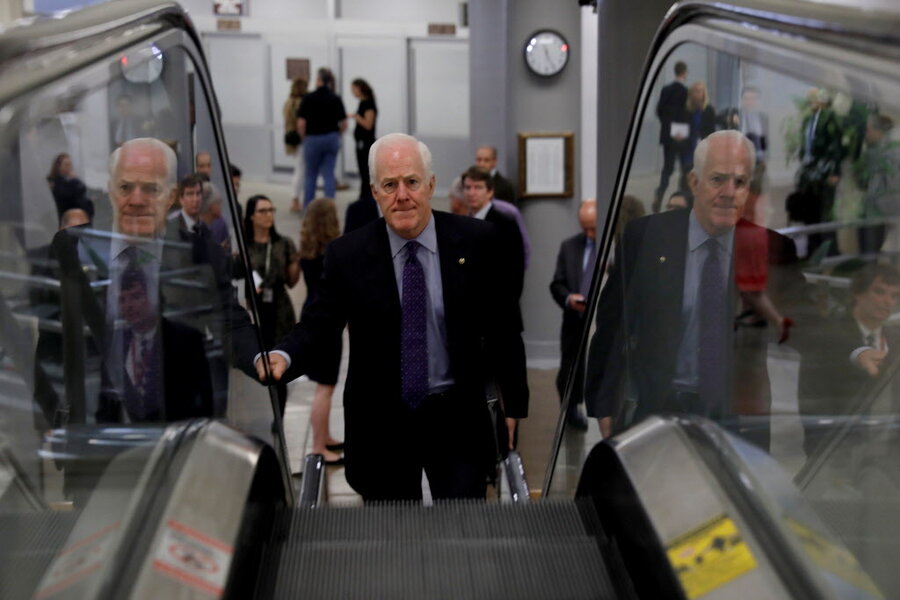Why GOP-run Congress didn’t fund Trump’s wall
| Washington
What happened to President Trump’s wall in this week’s bipartisan budget deal is a good way to look at the new political dynamic in Washington.
For it is a new dynamic. Up to this point – the cabinet confirmations, the Supreme Court justice, the regulatory rollbacks – all could be done with a GOP majority in Congress and a Republican in the White House.
But Congress is now in the budgeting phase, and budgeting – as well as most other major legislation – still requires clearing a 60-vote threshold in the Senate. For the first time since Mr. Trump took office, Republicans and Democrats actually have to work together to get something done.
Back to the wall. It’s not in there. There’s no $1.4 billion to start construction on a “big, beautiful” wall as the president requested. What that shows is the Democrats' clout, even as a minority party. They erected a solid wall of resistance so that not one penny could go to Trump’s expansive vision of concrete.
But here’s what did get in there: $1.5 billion for border security – technology and maintenance of existing infrastructure at the border, even if there’s nothing for new fencing, as the administration wanted. What this shows is the two parties finding common ground, something that America hasn’t seen much of in these early months.
Alas, it did not please the president.
Trump calls for a government shutdown
He showed his displeasure in a couple of tweets on Tuesday morning. Referring to this week’s $1.16 trillion budget deal – which will fund the government through Sept. 30 and which gave Democrats almost everything they wanted – Trump laid out three ways "to fix mess!”:
- Elect enough Republican senators in 2018 so that they can clear the 60-vote threshold by themselves (that’s how Democrats squeaked the Affordable Care Act past the Senate)
- Blow up the 60-vote rule for Senate legislation so that everything passes with a simple majority
- Blow up the government with a “good ‘shutdown’ ” in September – i.e., force the hand of Democrats.
These last two suggestions did not go down well with Senate Republicans such John Cornyn of Texas – in the Senate's GOP leadership – and reflect what America has so far come to know about the president: That he’s on a learning curve.
“It’s a free country, he’s entitled to express his views, as are we,” Senator Cornyn told reporters Tuesday.
But in a speech just minutes before on the Senate floor he vigorously argued against the party in control shutting down the government. And he defended the 60-vote threshold as a way for members to have their say in legislation and to forge lasting consensus on America’s big issues.
Here, again, the wall teaches a lesson. Even if the president were to have his way and the Senate tore down its 60-vote rule, not every issue splits neatly along partisan lines – though more and more it’s trending that way.
Take the wall, for instance.
Why some GOP lawmakers also oppose wall
Last month, The Wall Street Journal canvassed Democrat and Republican lawmakers from Southwest border states and found that none of them supported the president’s funding request to start wall construction, though Sen. Ted Cruz (R) of Texas “backs the overall idea of a wall,” the news organization reported. For next year, the president has requested $2.6 billion.
“You don’t have a single Republican on the border who’s for the wall,” Senate minority leader Charles Schumer (D) of New York told reporters Monday. He said he had spoken with seven or eight Republican senators who oppose the president’s project. “I don’t think it can pass,” the New Yorker said, looking ahead to the wrangling over next year’s budget, even while praising the bipartisan cooperation on this year's deal.
Border lawmakers and others have concerns about the president’s focus on a physical barrier. They point to all the ways to go over, under, or through a barrier. They raise issues of terrain and eminent domain, and of fear of Mexican retaliation by blocking US agriculture exports.
They also point to cost. Estimates on building a wall range wildly, from $12 billion to nearly $70 billion. Whatever it is, it’s hard to find any lawmaker who believes Mexico will pay for it.
“It’s not helpful to his goal and to my goal to just be talking about a border wall,” Cornyn told reporters on Tuesday, referring to Trump. “We need to talk about more than infrastructure. We need to talk about technology, we need to talk about personnel, and I’d like to see a comprehensive border security plan.”
And yet the president is still promising the wall. “We will build a wall folks, don’t even worry about it,” he said at his Harrisburg, Pa., rally over the weekend.
The way through this impasse looks to be a matter of definition and scope – redefining the wall as “border security” and taking a more multifaceted approach.
“If you’re talking about drones, if you’re talking about towers, if you’re taking about anti-tunneling, if you’re talking about increasing the manpower. Then that’s fine. That’s my view of what a wall is. Not just concrete,” says Sen. John McCain (R) of Arizona.
The president’s press secretary called the $1.5 billion in this week's deal “a down payment on border security.”






